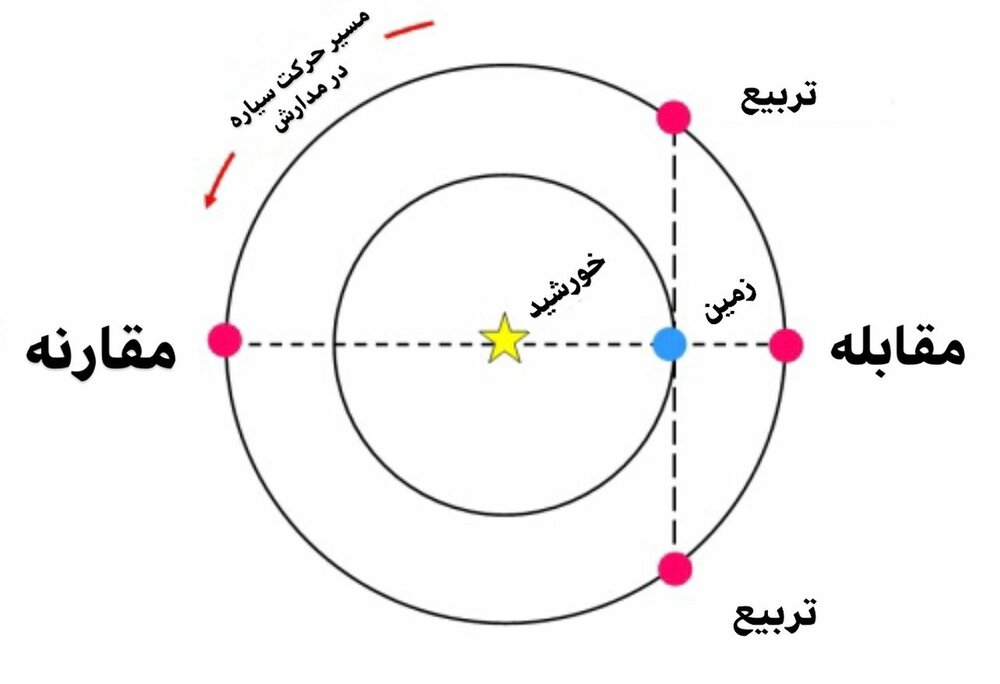What does "coping" mean in astronomy?
According to the reporter Immena, And based on a note provided by Fatemeh Fakhraeifard, a scientific expert at the Larestan Observatory, to this media; You may have heard that “confrontation” is the best time to observe a planet; But the question for you is what is confrontation? And which planets are in opposition?
Contrast in astronomy means that a planet is facing the sun. Planets orbiting the Sun outside of Earth’s orbit (Mars, Jupiter, Saturn, Uranus, and Neptune) – all can be in a collision position.
When the sun sets in the west and the planet rises in the east, the planet is in opposition. The collision point is the best time to observe the planet because mass is usually the closest distance to Earth and can be seen all night long. Of course, the confrontation position is also used to further explore new solar system objects, such as Kuiper belt objects and asteroids, and researchers often try to observe these objects when their maximum light is received by the sun.
Contrast from the point of view of ground observers
At the opposite point, the earth is in the middle of a line between an outer planet and the sun, and we see the sun at one end of the sky and the opposite planet in the opposite direction. As the planet descends below the horizon, the sun reappears above the horizon.
According to the celestial coordinate system, a collision for an outer planet occurs when the sun and that planet are exactly 180 degrees apart in the sky. Venus and Mercury can never be seen in the opposite position from Earth’s point of view because their orbits are closer to Earth than to the Sun; Therefore, it can never appear in the sky in front of the sun.

At sunset in the west, you will never see Venus in the east. The inner planets are always close to the Sun in our view, not more than 47 degrees from the Sun for Venus and 28 degrees from Mercury. Confrontations only happen to objects that are farther from the sun than the earth. We see collisions for Jupiter, Saturn, Uranus, and Neptune every year. Of course, we also see collisions on Mars, but Martian collisions occur almost every 27 months because Earth and Mars are very close in their orbits around the Sun. And their velocities in orbit are similar.
Why are contrasting planets interesting for sky enthusiasts?
During the collision, the planets are in front of the sun, so at sunset, the planets rise in opposition and are found in the sky all night long. In contrast, the planets are approximately closest to Earth; At such times we see the full brightness of that planet and the planet is in its brightest state and more details can be seen through telescopes.
If you say to yourself that this situation is very similar to the moon, you are right! In the full phase, the moon is directly in front of the sun in the sky, so it is fully illuminated and shows us its brightest state. Moving along its orbit, the Sun-Earth-Moon line bends and shows us what we know from the Earth as the phases of the Moon.
Confrontation from the perspective of alien planets
As in many other cases, the confrontation is everything from the point of view and depends on the position of the observer. We talked about this phenomenon from the perspective of Earthlings, but what about the rest of the planets? When an outer planet – let’s say Jupiter – is in opposition to us, the Earth is in that planet’s inner orbit. In other words, at the moment of confrontation, from the point of view of the terrestrial observer on Jupiter, they see the earth between their world and the sun. That is, the earth and the sun will be on one side of Jupiter’s sky, and the earth will be hidden in the sunlight.
Also consider that the Earth passes between the Sun and Jupiter as it moves in its orbit. So maybe one day, an observer from Jupiter will see that the earth is passing in front of the sun. In the sense that they will see the dark night of the earth and the phenomenon of transit will occur. The phenomenon that we currently see for Mercury and Venus.
Comments
Post a Comment